
Breaking the Code: Ancient Iran’s Linear Elamite Script Deciphered
september 2022 | Vol. 10.9
By François Desset, Kambiz Tabibzadeh, Matthieu Kervran, Gian Pietro Basello, and Gianni Marchesi
Research in the humanities achieves definitive results in very few cases. The decipherment of an ancient writing system is probably one of them. Successful decipherment efforts in the 20th century include Mycenaean Linear B (by Alice Kober, Michael Ventris, and John Chadwick), Mayan glyphs (by Yuri Knorozov and Tatiana Proskouriakoff), and Luwian/Anatolian hieroglyphs (started by Helmuth Theodor Bossert, Emil Forrer, Ignace J. Gelb, Bedřich Hrozný, and Piero Meriggi; continued by Emmanuel Laroche; and completed by David Hawkins and Anna Morpurgo-Davies). To this list can now be added an important writing system used in southern Iran between 2300 and 1880 BCE, the Linear Elamite script.
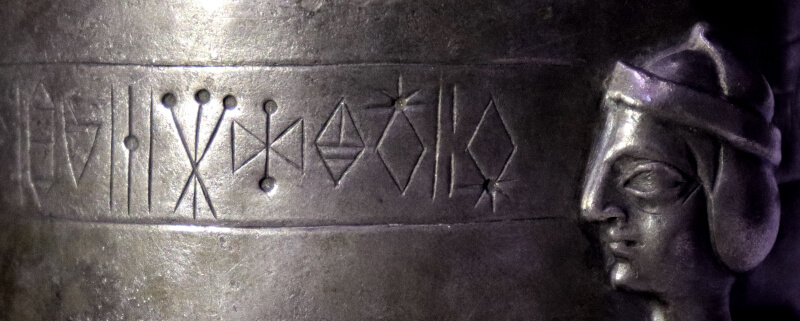
Detail of the Marv Dasht vessel, with an example of Linear Elamite writing (21st century BCE; courtesy of the National Museum of Iran).
First discovered in 1903 by the French Mission excavating at Susa in southwestern Iran, Linear Elamite (LE) had so far resisted decipherment, despite several attempts by great scholars of the past such as Ferdinand Bork, Carl Frank, Walther Hinz, and Piero Meriggi. Although these scholars were able to identify, precisely or approximately, some sign values of Linear Elamite, these early attempts were ultimately unsuccessful. The time was not yet ripe: the documentary base for Linear Elamite was still too narrow to allow scholars to go beyond identifying the phonetic values of a few sporadic signs.
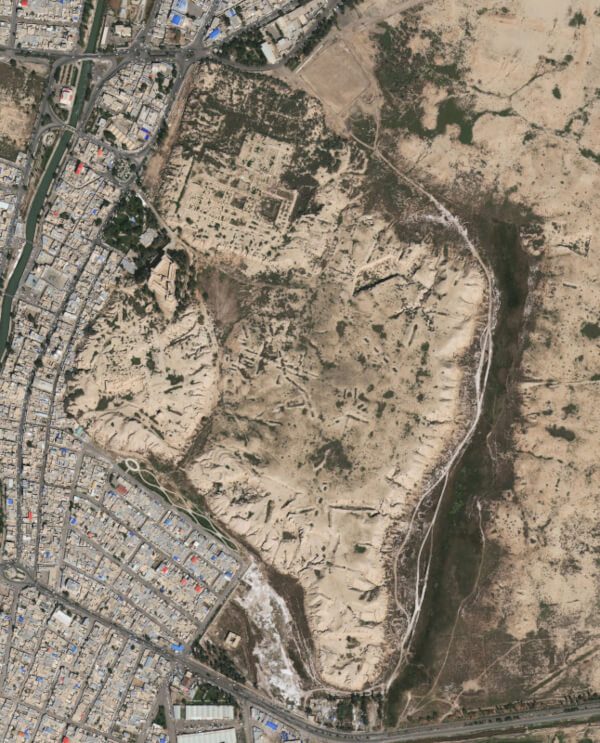
Aerial view of Susa (courtesy of the Cultural Heritage Base of Susa).
Starting in 2017, François Desset, then Kambiz Tabibzadeh and Matthieu Kervran worked intensively on the decipherment of Linear Elamite (first separately and then jointly), and were subsequently joined by Gian Pietro Basello and Gianni Marchesi. The results of this international collaborative effort were most recently made available to the scientific community through the publication of a paper entitled “The Decipherment of Linear Elamite Writing,” in the scholarly journal Zeitschrift für Assyriologie and Vorderasiatische Archäologie. A volume by the same authors containing editions of all the known LE inscriptions (a little over forty) will soon appear in the open-access series OrientLab Series Maior of the University of Bologna.
The starting point for the decipherment of Linear Elamite was provided by a small number of monuments from Susa, dating to the 22nd century BCE, bearing inscriptions in both the indigenous Linear Elamite script and the foreign cuneiform writing that had been imported from Mesopotamia. As the cuneiform texts are written in the Akkadian language (one of the languages that were spoken in neighboring Mesopotamia at that time), which is well known, they could be understood by us and attributed to a Susian ruler named Puzur-Sushinak. Written on the same monuments, side by side with the cuneiform inscriptions, the accompanying Linear Elamite inscriptions could reasonably be expected to have been commissioned by the same ruler and contain his name.
This inference turned out to be true: the cuneiform text on one of these monuments is a dedication to Sushinak, the main deity of Susa, by Puzur-Sushinak. Sushinak is the Akkadian name of the god; in Elamite, he was known as Insushinak; the fact that the two names — Puzur-Sushinak and Insushinak — are partially overlapping (their final parts coincide) made it relatively easy to identify the sign sequences recording them in the adjacent Linear Elamite inscription.
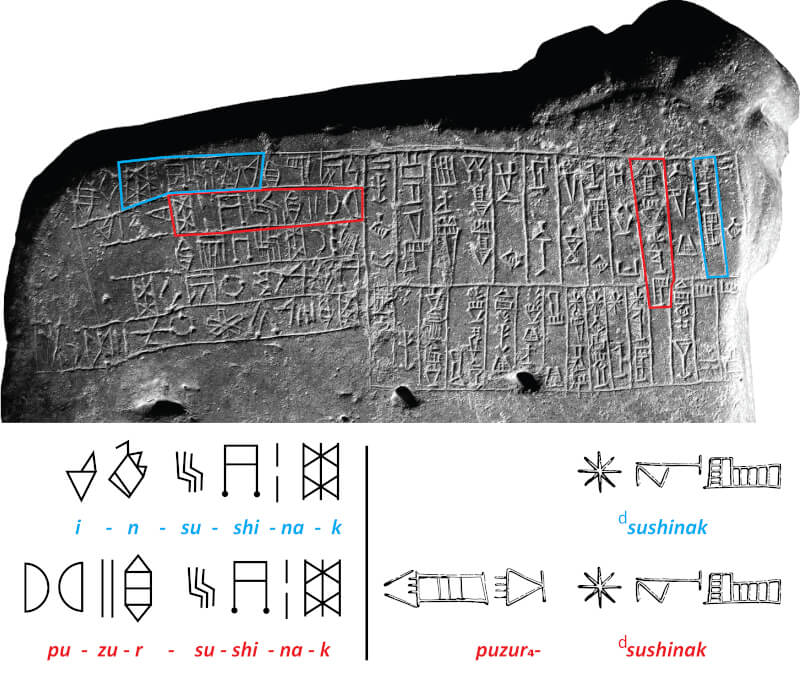
The so-called “Table au lion,” Susa, 22nd century BCE (courtesy of the Louvre, Paris). This stone monument displays an Akkadian text written in cuneiform on the right and an Elamite text in Linear Elamite script on the left. The sign sequences recording the proper nouns Insushinak/Sushinak and Puzur-Sushinak (written from right to left in the Linear Elamite text) are respectively framed in blue and red.
Additional, decisive material for the decipherment was provided by a new corpus of Linear Elamite texts inscribed on silver beakers of a particular type, which were brought to the attention of the scientific community at the beginning of the 2000s. Mainly held in the Mahboubian Collection, in London, these vessels allegedly come from the area of Kam-Firuz, close to the ancient city of Anshan/Anzan (modern Tal-e Malyan), an important archaeological site excavated by an American team in the 1970s.

Silver beakers allegedly from the Kam-Firuz area, displaying royal inscriptions written in Linear Elamite script. On the left (a) and in the center (b), texts of Itatu I (ca. 1980 BCE); on the right (c), a text of Pala-ishan (ca. 1900-1880 BCE) (photographs by François Desset; courtesy of the Mahboubian Collection).
The vessels can be dated on a typological basis to a period between 2050 and 1850 BCE. Because of this dating and their alleged provenance, their inscriptions could be assumed to contain the names of certain Elamite rulers who reigned during that time and the names of certain gods who were worshipped in the area. It was François Desset who first identified, already in 2017, the signs sequences corresponding to the names of the rulers Shilhaha and Eparti II and of the god Napiresha, the main deity of the Iranian plateau.
I remember perfectly how this happened. I was sitting in my flat in Tehran in the spring of 2017, playing with the sign sequences recorded in the inscriptions on these silver beakers. A specific sequence drew my attention: it consists of four signs, of which the first had already been identified as shi (thanks to the readings of the names Insushinak and Puzur-Sushinak in some Linear Elamite inscriptions from Susa; see above), and the last two are identical (that is, the same sign repeated twice). This sequence occurs in several inscriptions. Since an Elamite ruler bearing a name that begins with shi and ends with a repeated syllable, Shilhaha, is known from cuneiform sources to have ruled in the 20th century BC, it was tempting to associate the sequence in question to this royal name and read, accordingly, shi-l-ha-ha. Again, the starting hypothesis turned out to be true. This was the key, and after that, the rest came quite quickly. A few minutes later, I was reading the name of Shilhaha’s predecessor (and probably father), Eparti II (e-pa-r-ti). Finally, I identified the main god worshipped on the Iranian plateau, Napiresha (written either na-pi2-ri-sha or na-pi2-r-ri-sha), the “Great (resha) God (napi)” in the Elamite language. These three names alone allowed me to read eight additional signs (i.e., e, ha, l, pa, pi2, ri, sha, and ti; na, r, and shi being already provided by the previous identification of the Linear Elamite spelling of the name Puzur-Sushinak: pu-zu-r-su-shi-na-k).

The personal names Shilhaha and Eparti (i.e., the ruler Eparti II), and the divine name Napiresha written with Linear Elamite signs. For illustration purposes, the original order of the signs (from right to left) has been changed according to our left-to-right way of writing. Illustration by the authors.
Indeed, these Linear Elamite inscribed vessels contain highly standardized Elamite royal inscriptions belonging to different rulers reigning between 2000 and 1880 BCE. More importantly, their inscriptions share a number of linguistic features (proper nouns, titles, epithets, formulas, general phraseology) with several slightly later Elamite texts written in cuneiform.

Silver beaker bearing a royal inscription of the Elamite ruler Sewe-palar-huhpak (first half of the 18th century BCE) in cuneiform script and Elamite language (courtesy of the Mahboubian Collection).
This digraphia, where the same linguistic information (in the Elamite language) is recorded with two different types of writing — Mesopotamian cuneiform (the known) and Iranian Linear Elamite (the unknown) — is what really made it possible to decipher the Linear Elamite script in the end.

Example of biscripturalism relating to the same Elamite sentence: /manip sahip hurt kerep op(e) hutakna/, “May the manis (cultic objects?) of bronze be realized for my priests.” Above in Linear Elamite script (from a text of Itatu I; ca. 1980 BCE; see Fig. 4a above, lines 8-9), while below the same passage is reproduced in cuneiform writing (in an inscription of Sewe-palar-huhpak, first half of the 18th century BCE; see Fig. 7 above, lines 58-59). Illustration by the authors.
Champollion could rely on Coptic, the descendant of the ancient Egyptian language, and Ventris started from the assumption (which turned out to be true) that Mycenaean Linear B recorded an ancient Mycenaean form of Greek. Linear Elamite script could be deciphered thanks to a previously established (albeit partial) knowledge of the Elamite language through the cuneiform writing and translations of Elamite texts into Akkadian or Old Persian. It should be stressed, however, that our knowledge of Elamite grammar and lexicon is still far from satisfactory. This causes a situation similar to that of the Etruscan language: while we are now able to read most of the texts in Linear Elamite, our understanding in several cases is still only partial. In other words, even if the decipherment of Linear Elamite script is basically achieved, the translation of the Elamite language is still problematic.
The decipherment proved that Linear Elamite was used to record texts in the Elamite language. Probably a remnant of a former larger linguistic group, Elamite is considered an isolated language (i.e., it has no known linguistic cognates). This situation prevents any linguistic comparisons, despite hypotheses trying to connect Elamite with the Dravidian languages of India, the Afro-Asiatic linguistic group, the Caucasian, or even the Indo-European languages. Some scholars maintain that Elamite, or rather a descendent of it, was spoken in southwestern Iran until ca. 1000 CE, as documented by Persian geographers writing in Arabic, reporting the existence of a language, Khuzi, said to be very difficult to learn and that was neither Arabic, Persian, Syriac, nor Hebrew.
Be that as it may, the newly deciphered Linear Elamite script, which is purely phonetic (signs represent vowels, consonants, and syllables of the CV [consonant + vowel] type), should, among other things, also enable us to improve our understanding of this fascinating language, one of the oldest languages of human history to have come down to us. For the first time, the Elamites are able to speak to us through their own indigenous script. Moreover, the decipherment of Linear Elamite could pave the way to the decipherment of the related Proto-Elamite writing, which was used in ancient Iran in the last centuries of the 4th millennium BCE. But that is another story.
François Desset is a research fellow at the University of Teheran and the CNRS team Archeorient (UMR 5133), Maison de l’Orient et de la Méditerranée, Lyon. He specializes in ancient Iranian writings and archaeology.
Kambiz Tabibzadeh is Professor of Management at Eastern Kentucky University. He is also a student of the Elamite language and civilization.
Matthieu Kervran is an independent researcher working on the decipherment of ancient writing systems.
Gian Pietro Basello is Associate Professor of Elamite and Ancient Iranian Languages at “L’Orientale” University of Naples.
Gianni Marchesi is Associate Professor of Assyriology at the University of Bologna.
Further Reading:
Desset, F. 2012. Premières écritures iraniennes: Les systèmes proto-élamite et élamite linéaire. Napoli: Università degli Studi di Napoli “L’Orientale”.
Desset, F. 2018. “Nine Linear Elamite Texts Inscribed on Silver “‘Gunagi’” Vessels (X, Y, Z, F′, H′, I′, J′, K′ and L′): New Data on Linear Elamite Writing and the History of the Sukkalmah Dynasty,” Iran 56, pp. 105-143.
Desset, F., Tabibzadeh, K., Kervran, M., Basello, G. P. & G. Marchesi. 2022. “The Decipherment of Linear Elamite Writing,” Zeitschrift für Assyriologie und Vorderasiatische Archäologie 112, p. 11-60.
Desset, F., Tabibzadeh, K., Kervran, M., Basello, G. P. & G. Marchesi. forthcoming. Linear Elamite Inscriptions and Related Cuneiform Texts. Bologna: Università di Bologna, Dipartimento di Storia, Culture, Civiltà / Ante Quem.
Gelb, I. J. 1963. A Study of Writing. Revised edition. Chicago: The University of Chicago Press.
Kervran, M. 2019. “Proposition pour le déciffrement de l’élamite linéaire,” SocArXiv, Dec. 6, doi: 10.31235/osf.io/jc4xs
Pope, M. 1999. The Story of Decipherment: From Egyptian Hieroglyphs to Maya Script. Revised edition. New York: Thames and Hudson.
How to cite this article
Desset, F., Tabibzadeh, K., Kervran, M., Basello, G. P. and G. Marchesi. 2022. “Breaking the Code: Ancient Iran’s Linear Elamite Script Deciphered.” The Ancient Near East Today 10.9. Accessed at: https://anetoday.org/desset-irans-linear-elamite-deciphered/.
Want to learn more?
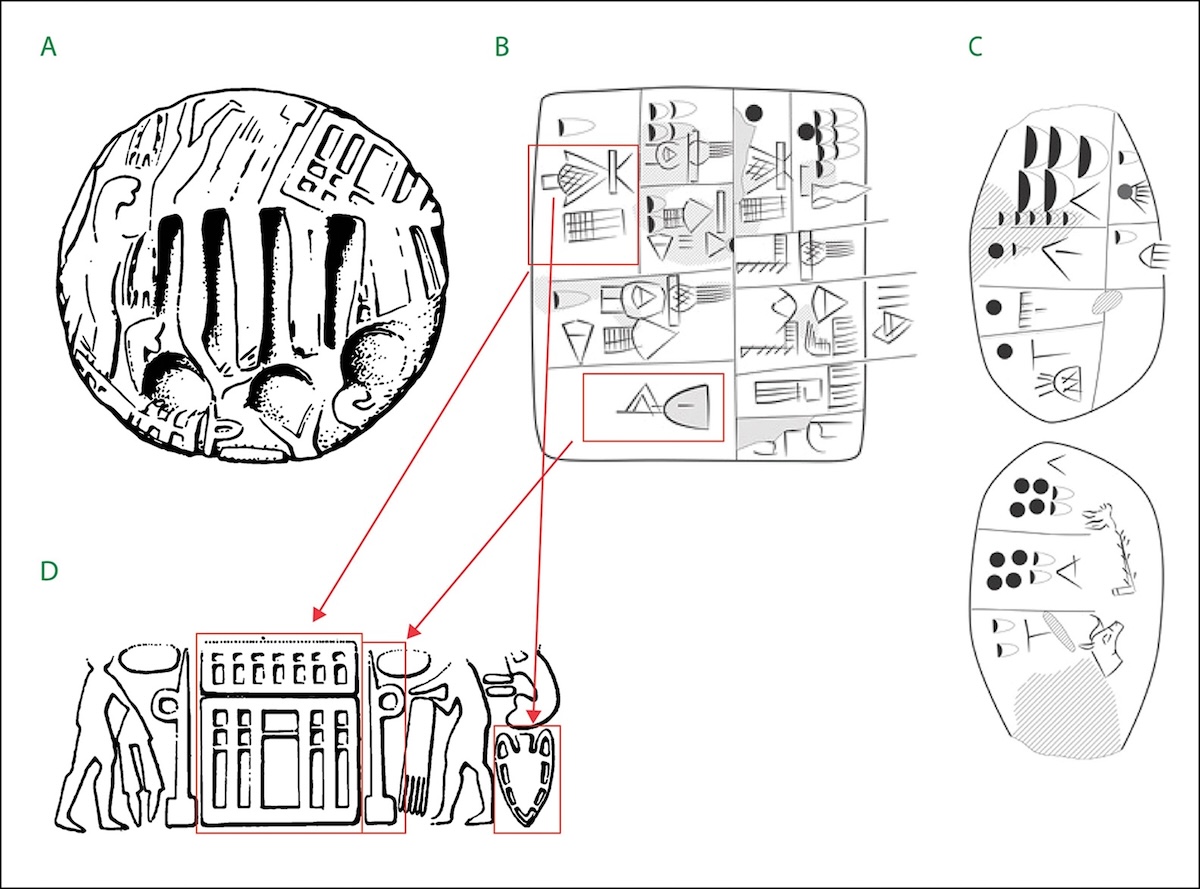
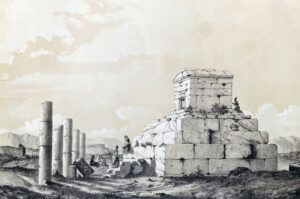



Post a comment